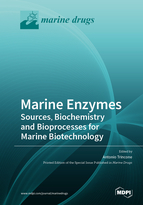Marine Enzymes: Sources, Biochemistry and Bioprocesses for Marine Biotechnology
A special issue of Marine Drugs (ISSN 1660-3397).
Deadline for manuscript submissions: closed (30 June 2019) | Viewed by 108048
Special Issue Editor
Interests: biocatalysis; marine enzymes; marine glycosidases; marine biotechnology; oligosaccharides
Special Issues, Collections and Topics in MDPI journals
Special Issue Information
Dear Colleagues,
The interdisciplinary study of the complexity of marine habitats has increased knowledge of marine forms of life. Marine-originating biocatalysts are attractive to biocatalysis practitioners for novel biochemical and stereochemical features. An in-depth knowledge of the precise biological functions of genes, proteins and enzymes within the marine ecosystem is still considered one of the least developed fields of research; even though in recent years marine habitat has been recognized as an untapped source of novel enzymes and metabolites. Expanding the range of enzymes from marine organisms is one of the key points in future marine biotechnology roadmaps. In particular, the importance of marine biocatalysts is recognized when addressing the exploration of chemical and biological diversity for novel materials and products, and for biomass production and processing, both used in foresight analyses for future research in this field. Convincing examples, such as the specific diversity of molecular assets of biocatalysis using marine enzymes with respect to terrestrial counterparts, are increasingly reported in the literature regarding all marine sources (not only microorganisms and fungi, plants and animals, but also extremophiles and symbiotic microorganisms). Indeed the plasticity of biological adaptations of marine organisms to the wide range of environmental events in specific environments (temperature, salinity, tides, pressure, radiation, light, etc.) provides an enormous reservoir of interesting subjects for basic and applicative studies.
Processes using marine enzymes and marine biomasses are central in different biotechnological fields of applications: (i) in a biorefinery value-chain with marine enzymes for biochemical processes; (ii) in food industries for enzymatic procedures in seafood processing; (iii) in fields of fine chemicals—in pharmaceutical, cosmetics, agriculture and environmental sectors—enzymatic treatments are a tool to improve efficiency and selectivity for extraction/manipulation of structurally complex marine molecules to gain access to bioactive compounds and to provide complex core blocks for hemisynthesis; (iv) the field of marine biomarkers and applications in pollution monitoring (biosensor) and bioremediation could also be of high significance for the appreciation of marine sources for enzymes.
Preeminent conclusions by many scientists in the field of marine biotechnology emphasize that due to marine biological diversity and the specificity of biological metabolisms, the study of marine biocatalysts on a global scale is just starting and possesses huge potential for development and applications with industrial benefits.
In this Special Issue, along with contributions regarding the potential of marine enzymes as useful tools in biocatalysis, results of enzymatic bioprospecting in gross marine environments will also be acknowledged. In addition, studies about structural characterizations, biological functions and aspects related to the complexity of marine enzyme-based bioprocesses will be hosted.
Dr. Antonio Trincone
Guest Editor
Manuscript Submission Information
Manuscripts should be submitted online at www.mdpi.com by registering and logging in to this website. Once you are registered, click here to go to the submission form. Manuscripts can be submitted until the deadline. All submissions that pass pre-check are peer-reviewed. Accepted papers will be published continuously in the journal (as soon as accepted) and will be listed together on the special issue website. Research articles, review articles as well as short communications are invited. For planned papers, a title and short abstract (about 100 words) can be sent to the Editorial Office for announcement on this website.
Submitted manuscripts should not have been published previously, nor be under consideration for publication elsewhere (except conference proceedings papers). All manuscripts are thoroughly refereed through a single-blind peer-review process. A guide for authors and other relevant information for submission of manuscripts is available on the Instructions for Authors page. Marine Drugs is an international peer-reviewed open access monthly journal published by MDPI.
Please visit the Instructions for Authors page before submitting a manuscript. The Article Processing Charge (APC) for publication in this open access journal is 2900 CHF (Swiss Francs). Submitted papers should be well formatted and use good English. Authors may use MDPI's English editing service prior to publication or during author revisions.







